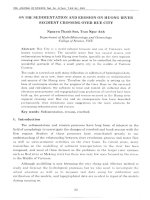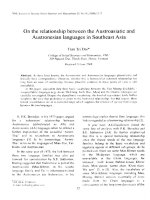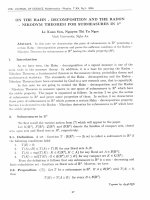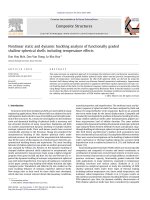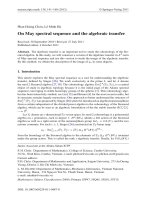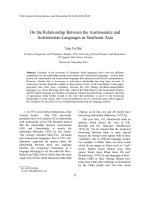DSpace at VNU: On acoustoelasticity and the elastic constants of soft biological tissues
Bạn đang xem bản rút gọn của tài liệu. Xem và tải ngay bản đầy đủ của tài liệu tại đây (504.6 KB, 12 trang )
Journal of
Mechanics of
Materials and Structures
ON ACOUSTOELASTICITY AND THE ELASTIC CONSTANTS
OF SOFT BIOLOGICAL TISSUES
Pham Chi Vinh and Jose Merodio
Volume 8, No. 5-7
July–September 2013
msp
JOURNAL OF MECHANICS OF MATERIALS AND STRUCTURES
Vol. 8, No. 5-7, 2013
msp
dx.doi.org/10.2140/jomms.2013.8.359
ON ACOUSTOELASTICITY AND THE ELASTIC CONSTANTS
OF SOFT BIOLOGICAL TISSUES
P HAM C HI V INH AND J OSE M ERODIO
We analyze the acoustoelastic study of material moduli that appear in the constitutive relations that
characterize the response of anisotropic nonlinearly elastic bodies, in particular, materials reinforced with
one set of fibers along one direction. Studies dealing with acoustoelastic coefficients in incompressible
solids modeled by means of strain-energy density functions expanded up to different orders in terms of
the Green strain tensor can be found in the literature. In this paper, we connect that analysis and the
parallel one developed from the general theory of nonlinear elasticity which is based on strain energies
that depend on the right Cauchy–Green deformation tensor. Establishing this relation explicitly will
improve understanding of the mechanical properties of soft biological tissues among other materials.
1. Introduction
Determination of the acoustoelastic coefficients in incompressible solids has very recently attracted a
lot of attention since these analyses give an opportunity to capture the mechanical properties of such
materials, among other applications [Bigoni et al. 2007; 2008; Destrade et al. 2010b].
An incompressible transversely isotropic model has recently been analyzed by Destrade et al. [2010a]
in which the strain-energy density is given by
W D I2 C 13 AI3 C ˛1 I42 C ˛2 I5 C ˛3 I2 I4 C ˛4 I43 C ˛5 I4 I5 ;
(1)
where
I2 D tr.E 2 /;
I3 D tr.E 3 /;
I4 D M .EM /;
I5 D M .E 2 M /;
(2)
E is the Green strain tensor, M is the unit vector that gives the undeformed fiber direction, and , ˛1 ,
˛2 and A, ˛3 , ˛4 , ˛5 are second and third-order elastic constants, respectively (the order is given by the
exponent of E ). To evaluate the elastic constants Destrade et al. established formulas for the velocity
waves. The formulas are given as first-order polynomials in terms of the elongation e1 , which is defined
by D 1 C e1 , where is the principal stretch in the direction that gives both the fiber direction and the
direction of uniaxial tension. The speeds of infinitesimal waves do provide a basis for the acoustoelastic
evaluation of the material constants [Destrade and Ogden 2010].
Soft biological tissues are anisotropic solids due to the presence of oriented collagen fiber bundles
[Holzapfel et al. 2000; Destrade et al. 2010a]. To make the model (1) more general and able to capture
Keywords: incompressible transversely isotropic elastic solids, soft biological tissue, wave velocity, elastic constants.
359
360
PHAM CHI VINH AND JOSE MERODIO
soft biological tissue mechanical behavior a fourth-order incompressible strain-energy function has been
analyzed in [Vinh and Merodio 2013], namely
W D I2 C 13 AI3 C ˛1 I42 C ˛2 I5 C ˛3 I2 I4 C ˛4 I43
C ˛5 I4 I5 C ˛6 I22 C ˛7 I2 I42 C ˛8 I2 I5 C ˛9 I44 C ˛10 I52 C ˛11 I3 I4 ; (3)
where ˛6 ; : : : ; ˛11 are fourth-order elastic constants. The results show that linear corrections to the
acoustoelastic wave speed formulas involve second and third-order constants, and that quadratic corrections involve second, third, and fourth-order constants, in agreement with [Hoger 1999]. Indeed, this
is precisely the rationale behind the considered expansions (1) and (3) and the reason to develop the
acoustoelastic wave speed formulas in terms of constitutive models that depend on the invariants of the
Green strain tensor. Nevertheless, in this paper we develop acoustoelastic wave speed formulas in terms
of constitutive models that depend on the invariants of the right Cauchy–Green tensor.
The model (3) has 13 elastic constants. It would be perfectly justifiable to question the efficacy of
a model that depends on such a number of elastic constants. It is not easy to determine the structure
of these material constants by any correlation with experiments. This makes a careful scrutiny of the
nature of these constitutive models necessary in order to determine which of these elastic constants must
be retained in the development of models. The models have to be well understood, and we can only do
this if we analyze their structure. In passing, we mention that there has been lately in the literature some
controversy regarding the use of planar tests to characterize anisotropic nonlinearly elastic materials. For
a general discussion refer to [Holzapfel and Ogden 2009].
The more available formulations there exist in the literature to characterize elastic materials the more
possibilities researchers have to capture the structure of the constitutive models. Furthermore, while
physical acousticians are interested in third-order constants for anisotropic solids, workers in nonlinear
elasticity, and, in particular, in soft biological tissue, use finite extensions involving fourth-order constants.
In addition, soft biological tissue is modeled using general nonlinear elasticity theory expressed in terms
of the right Cauchy–Green deformation tensor (see [Holzapfel et al. 2000]), among other formulations.
Therefore, to develop the acoustoelastic wave speed formulas in terms of general nonlinear elasticity
theory, that is, in terms of the right Cauchy–Green tensor, may improve our understanding of the mechanical response of soft tissue, among other materials. It is to this aspect of the problem that this study
is directed.
In this paper we only address the subtle differences between the two approaches. To the best of
our knowledge this relation has not been explored in the literature and we believe that the cumbersome
technical details of the analysis are worthy of investigation. Our purpose is twofold: on the one hand,
we illustrate the analysis for these nonisotropic elastic energy functions; on the other, we connect the
acoustoelastic formulations of both material models, the one depending on the Green strain tensor and
the one depending on the right Cauchy–Green tensor.
The layout of the paper is as follows. In Section 2, we introduce briefly the main governing equations.
Section 3 is devoted to the acoustoelastic analysis of constitutive models that depend on the invariants
of the right Cauchy–Green strain tensor. In particular, the equations governing infinitesimal motions
superimposed on a finite deformation have been used to establish formulas for the velocity of (plane
homogeneous) shear bulk waves propagating in general soft biological tissues subject to uniaxial tension
ON ACOUSTOELASTICITY AND THE ELASTIC CONSTANTS OF SOFT BIOLOGICAL TISSUES
361
or compression. Furthermore, the analysis connects with the constitutive model (3). In Section 4 we give
some conclusions.
2. Overview of the main equations
We consider an elastic body whose initial geometry defines a reference configuration, which we denote
by Br , and a finitely deformed equilibrium configuration B0 . The position vectors of representative
particles in Br and B0 are denoted by X and x, respectively. It is well known that x D x.X ; t/, where
t is time. The deformation gradient tensor associated with the deformation Br ! B0 is denoted by F .
2.1. Material model. Soft tissue is modeled as an incompressible transversely isotropic elastic solid.
The most general transversely isotropic nonlinear elastic strain-energy function depends on F through
the right Cauchy–Green tensor C , which is C D F T F , and we therefore consider to depend on the
invariants of the tensor C . It is well known that E D .C I/=2, where I is the identity tensor. The
isotropic invariants of C most commonly used are the principal invariants, defined by
I1 D tr C ;
I2 D 21 Œ.tr C /2
tr.C 2 /;
I3 D det C :
(4)
The (anisotropic) invariants associated with M and C are usually taken as (see, for instance, [Merodio
and Saccomandi 2006])
I4 D M .CM /; I5 D M .C 2 M /:
(5)
It follows that for incompressible materials D .I1 ; I2 ; I4 ; I5 / since I3 D 1.
In the Appendix several expressions that are needed in this analysis are given. The corresponding
Cauchy stress tensor for using the relations (A.4) and (A.6) yields
D pI C 2
1B
C2
B 2/ C 2
2 .I1 B
4m ˝ m C 2
5 .m ˝ Bm C Bm ˝ m/;
(6)
where p is the hydrostatic pressure arising from the incompressibility constraint, B D FF T , and m D
FM gives the deformed fiber direction. This expression in indicial notation is
ij
D pıij C 2
1 Bij
C2
2 .I1 ıij
Bi /Bj C 2
4 mi mj
C2
5 .Bj
m mi C Bi m mj /: (7)
It follows using (7) that
pD2
1;
4C2
5
D 0;
(8)
in the reference configuration where F D I and the Cauchy stress components are zero.
2.2. Linearized equations of motion. The linearized equations of motion for incompressible materials
are summarized below. For a complete derivation see [Ogden and Singh 2011]. From B0 , the linearized
incremental form of the equations of motion and the incompressibility constraint, in component form,
are written as
A0piqj uj ;pq p ;i D ui;t t ; ui;i D 0;
(9)
respectively, where ui .x; t/ is the small time-dependent displacement increment, a comma indicates
differentiation with respect to the spatial coordinate or with respect to t, p is the time-dependent pressure
increment, and
362
PHAM CHI VINH AND JOSE MERODIO
A0piqj D Fp˛ Fqˇ
@2
:
@Fi˛ @Fjˇ
The subscript 0 indicates the so-called pushed-forward quantity from the initial reference configuration
to the finitely deformed equilibrium configuration. We give its specialization to the situation in which
there is no finite deformation and B0 coincides with Br . The elasticity tensor A0piqj is given in (A.7).
Under these conditions, customarily, the subscript 0 on A0 is omitted, and in what follows we do so.
2.3. Homogeneous plane waves. We apply the equation of motion and the incompressibility condition
to the analysis of homogeneous plane waves. In particular, we consider the incremental displacement u
and Lagrange multiplier p to have the forms
u D f .n x
vt/d;
p D g.n x
vt/;
(10)
where d is a constant unit (polarization) vector, the unit vector n is the direction of propagation of the
plane wave, v is the wave speed, f is a function that need not be made explicit but is subject to the
restriction f 00 ¤ 0, and g is a function related to f . A prime on f or g indicates differentiation with
respect to its argument.
Substitution of (10) into (9) then yields
ŒQ.n/d
v 2 df 00
g 0 n D 0;
d n D 0;
(11)
where the (symmetric) acoustic tensor Q.n/ is defined by
Qij .n/ D Apiqj np nq :
(12)
The elasticity tensor Apiqj is given in (A.7). Now, we just give the main result. For a complete derivation
see [Ogden and Singh 2011]. It follows that for a given n and d the wave speed v is obtained from
v 2 D ŒQ.n/d d:
(13)
3. An approach to finding formulas for the speeds
of homogeneous plane waves using general nonlinear elasticity theory
We now describe the loading and geometric case that will be used in the analysis that follows. Consider
a rectangular block of a soft transversely isotropic incompressible elastic solid whose faces in the unstressed state are parallel to the .X1 ; X2 /, .X2 ; X3 /, and .X3 ; X1 /-planes and with the fiber direction M
parallel to the X1 -direction. Suppose that the sample is under uniaxial tension or compression with the
direction of tension parallel to the X1 -axis. It is easy to see that the sample is subject to x1 D 1 X1 ,
x2 D 2 X2 , and x3 D 3 X3 , and whence
F D diag.
1;
2;
3 /;
(14)
in which
1
D ;
2
D
3
D
1=2
;
> 0;
(15)
where k are the principal stretches of deformation. Note that the faces of the deformed block are parallel
to the .x1 ; x2 /, .x2 ; x3 /, and .x3 ; x1 /-planes.
ON ACOUSTOELASTICITY AND THE ELASTIC CONSTANTS OF SOFT BIOLOGICAL TISSUES
363
The analysis can now focus on different cases. We consider motion in the .x1 ; x2 /-plane (a plane that
contains the deformed fiber direction) with n1 D cos  D c, n2 D sin  D s, d1 D sin Â, and d2 D cos Â,
where  is the angle between n and the x1 -direction. The wave speed is, under these conditions, obtained
using (13), (12), and (A.7) and can be written as
v 2 D Apiqj np nq di dj
D A1212 c 4 C 2.A1222
A1112 /c 3 s C .A1111 C A2222
2A1221 /c 2 s 2
2A1122
C 2.A1121
A2221 /cs 3 C A2121 s 4 :
(16)
We now assume the situation described in (14) and investigate propagation in the fiber direction, that
is, n coincides with the deformed fiber direction, which initially is in the X1 -direction. In this case, the
relevant term in (16) is
2
2
2 2
4
2
2 2
2 2
1 1 C 2 2 .I1 1
1 2
1 / C 2 4 m1 C 2 5 Œ2m1 B1 m C 2 m1 C 1 m2
C 4 44 m21 m22 C 2 55 .m1 B2 m C m2 B1 m /2 C 4 45 2m1 m2 .m1 B2 m C m2 B1 m /
C 2 1 21 C 2 2 21 23 C 2 4 m21 C 2 5 Œ2m1 B1 m C 21 m22 C 22 m21
C 4 44 m21 m22 C 4 55 .m1 B2 m C m2 B1 m /2 C 8 45 m1 m2 .m1 B2 m C m2 B1 m /:
A1212 D 2
Considering, further, that in this case the components of m are m1 D 1 and m2 D 0 the wave speed
v12 is
2
v12
D A1212 D 2 1 21 C 2 2 21 23 C 2 4 21 C 2 5 .2 41 C 21 22 /:
(17)
On the other hand, and with a parallel argument, the wave speed for the analysis of propagation in
the perpendicular-to-the-fiber direction denoted by v21 , that is, n is perpendicular to the deformed fiber
direction, which initially is in the X1 -direction, yields using (16)
2
v21
D A2121 D 2
2
1 2C2
2 2
2 2 3C2
2 2
5 1 2:
(18)
It follows using (7), particularized for the (uniaxial) conditions at hand, (17), and (18) that
A1212
A2121 D
1
2:
(19)
We do not pursue here the study of these relations. For further details, we refer to [Ogden and Singh
2011], which also establishes connections between the identities given with the formulation developed
here and the identities developed by Biot [1965] with his formulation.
1=2
Now, we consider 1 D 1 C e1 for e1 sufficiently small. By incompressibility 2 D 3 D 1 , and
it follows that 21 23 D 21 22 D 1 D 1 C e1 . Using these expressions, (4), and (5), the invariants Ii in
terms of e1 are
I1 D
I2 D
I4 D
I5 D
2
2
2
2
2
2
1
1 C 2 C 3 D 1 C 2 2 D 1 C 2e1 C e1 C 2.1 C e1 /
2
2
2
2
1 C 2 2 D 1 2e1 C 3e1 C 2.1 C e1 / D 3 C 3e1 ;
2
2
1 D 1 C 2e1 C e1 ;
4
2
1 D 1 C 4e1 C 6e1 :
D 3 C 3e12 ;
(20)
364
PHAM CHI VINH AND JOSE MERODIO
Expansion of (17) requires the expansion of the different derivatives
using the chain rule and (20) that
1D
D
.o/
1 C e1
D
.o/
1 C 2e1
where
i
d
.o/
1 C e1 de
1
D
.o/
1
2
2
1 d
C e12 2
2 de
e1 D0
ˇ
ˇ
1ˇ
1
.o/
14 C 4
.o/
14 C2
is the value of
.o/
i C2
.o/
i4 C 2
.o/
15
.o/
15
1
ˇ
ˇ
1ˇ
i,
i D 1; 2; 4; 5, in (17). One finds
e1 D0
1
d
C e12
Œ6 11 e1 C 6
2 de1
1
.o/
.o/
C e12 6 11 C6 12 C2
2
12 e1 C
.o/
14 Ca2
14 .2C2e1 /C
.o/
15 C4
ˇ
ˇ
15 .4C12e1 / ˇ
e1 D0
.o/
144 C16
.o/
145 C16
.o/
155
;
in the reference configuration. Furthermore, it is easy to obtain that
.o/
i5
.o/
i1 C 3
e1 C 3
.o/
i2 C
.o/
i4 C 6
.o/
i5 C 2
.o/
i44 C
.o/
i45 C 8
.o/
i55
e12 ; (21)
where i can take the values 1, 2, 4, and 5.
Use of (21) and (17) yields for the wave speed, disregarding terms of order higher than 2 in e1 ,
.o/
.o/
.o/
.o/
.o/
.o/
.o/
.o/
.o/
.o/
1 C 2 2 C 2 4 C 6 5 C e1 4 1 C 2 12 C 4 4 C 18 5 C 4 14 C 8 15
.o/
.o/
.o/
.o/
.o/
.o/
.o/
.o/
C 4 24 C 8 25 C 4 44 C 20 45 C 24 55 C e12 2 1 C 2 4 C 24 5
.o/
.o/
.o/
.o/
.o/
.o/
.o/
.o/
.o/
.o/
C 8 14 C 2 15 C 4 24 C 2 25 C 8 44 C 45 C 36 45 C 2 55 C 6 11 C 12 12
.o/
.o/
.o/
.o/
.o/
.o/
.o/
.o/
.o/
.o/
C 8 14 C 30 15 C 6 22 C 8 24 C 30 25 C 2 44 C 18 45 C 36 55 C 4 144 C 16 145
.o/
.o/
.o/
.o/
.o/
.o/
.o/
.o/
C 16 155 C 4 244 C 16 245 C 16 255 C 4 444 C 30 445 C 64 455 C 48 555 :
(22)
2
v12
D2
This formula gives the general acoustoelastic wave speed for constitutive models that depend on the
invariants of the right Cauchy–Green tensor. This completes the first purpose of our analysis. Now, we
focus on the second purpose, which is to connect this formulation and the one developed for constitutive
models that depend on invariants of the Green strain tensor.
The relations between both invariant formulations Ii and Ii are established though C and the wellknown Cayley–Hamilton theorem, that we write as
C 3 D I1 C 2
I2 C C I;
tr.C 3 / D I1 .I1
2
2I2 /
I1 I2 C 3:
Hence, the invariants Ii in terms of Ii
are
2
I2 D tr.E 2 / D
1
4
tr.C 2
2C C I/ D 14 .I1
I3 D tr.E 3 / D
1
8
tr.C 3
3C 2 C 3C C I/ D 18 .I1
I4 D M .EM / D 21 .I4
I5 D M .E 2 M / D 41 .I5
2I2
2I1 C 3/;
3
3I1 I2
2
3I1 C 6I2 C 3I1 /;
(23)
1/;
2I4 C 1/:
Using (23) the constitutive model (3) (or any other model written in terms of the invariants Ii ) can be
written in terms of the invariants Ii and the same constants , A, and ˛1 ; : : : ; ˛11 . Then, (22) for that
ON ACOUSTOELASTICITY AND THE ELASTIC CONSTANTS OF SOFT BIOLOGICAL TISSUES
365
particular model after a lengthy but straightforward calculation yields
2
v12
D
C 12 ˛2 C 3 C 14 A C 2˛1 C 25 ˛2 C ˛3 C 21 ˛5 e
2
7
3
C 5 C 74 A C 5˛1 C 5˛2 C 5˛3 C 3˛4 C 15
4 ˛5 C 3˛6 C ˛7 C 4 ˛8 C ˛10 C 4 ˛11 e : (24)
This formula was obtained in [Vinh and Merodio 2013]. Furthermore, the result given in [Destrade et al.
2010a] is a special case of the approximation (24) when ˛k D 0 and k D 6; 11.
4. Conclusions
The motivation behind this analysis is the possibility of capturing the mechanical properties of soft
transversely isotropic incompressible nonlinear elastic materials, such as certain soft biological tissues,
using acoustoelasticity theory. The constitutive model is given as a strain-energy density function that
depends on the invariants of the right Cauchy–Green tensor. The equations governing infinitesimal motions superimposed on a finite deformation have been used in conjunction with the constitutive law to
examine the propagation of homogeneous plane waves. The speeds of homogeneous plane waves have
been derived. Furthermore, the differences between this theoretical framework and the parallel one
obtained for constitutive models that depend on the Green strain tensor have been highlighted. The use
of both acoustoelastic wave speed framework formulations may help to scrutinize the nature of the elastic
constants as well as to decide which elastic constants must be retained in the development of models.
Appendix: Derivatives of the invariants and the elasticity tensor
The expressions for the stress and elasticity tensors require the calculation of
N
i
@Ii
@F
N
N
X
@
D
@F
iD1
(A.1)
and
N
XX
@2 Ii
C
i
@F @F
X
@2
D
@F @F
ij
iD1 j D1
iD1
@Ij
@Ii
˝
;
@F
@F
(A.2)
where we have used the shorthand notations i D @ =@Ii , ij D @2 =@Ii @Ij , i; j D 1; 2; : : : ; N .
For the considered incompressible material the nominal stress is
SD
@
@F
pF
1
5
X
D
i
@Ii
@F
pF
iF
@Ii
@F
pI:
iD1; i¤3
1
;
(A.3)
and the corresponding Cauchy stress is
DF
@
@F
pI D
5
X
iD1
i¤3
(A.4)
366
PHAM CHI VINH AND JOSE MERODIO
The elasticity tensor is given by
AD
X
@2
D
@F @F
1ÄiÄ5
i¤3
X
@2 I i
C
i
@F @F
X
ij
1ÄiÄ5 1Äj Ä5
i¤3
j ¤3
@Ij
@Ii
˝
:
@F
@F
(A.5)
This requires expressions for the derivatives of the invariants, which are
@I1
@I2
@I4
D 2Fi˛ ;
D 2.I1 Fi˛ Fk˛ Fkı Fiı /;
D 2M˛ Fiı Mı ;
@Fi˛
@Fi˛
@Fi˛
@I5
@2 I1
D 2ıij ı˛ˇ ;
D 2.M˛ Fiı Cı M C C˛ M Fiı Mı /;
@Fi˛
@Fi˛ @Fjˇ
@2 I2
D 2.2Fi˛ Fjˇ Fiˇ Fj˛ CC
@Fi˛ @Fjˇ
@2 I 4
D 2ıij M˛ Mˇ ;
@Fi˛ @Fjˇ
ıij ı˛ˇ Bij ı˛ˇ C˛ˇ ıij /;
(A.6)
@2 I5
D 2ıij .M˛ Cˇ C Mˇ C˛ /M C 2Bij M˛ Mˇ
@Fi˛ @Fjˇ
C 2ı˛ˇ Fi M Fj ı Mı C 2.Fiˇ Fj M˛ C Fj˛ Fi Mˇ /M :
The pushed-forward quantity from the initial reference configuration to the finitely deformed equilibrium configuration of A is denoted A0 . We give its specialization to the situation in which there is no
finite deformation and B0 coincides with Br . The components of A0 in the reference configuration for
using (A.6), the chain rule, and the conditions (8) can be arranged in the form
A0piqj
D Fp˛ Fqˇ
D2
@2
@Fi˛ @Fjˇ
1 ıij Bpq
C2
2 .2Bip Bj q
Biq Bjp C I1 ıij Bpq
Bij Bpq
ıij .B 2 /pq / C 2
4 ıij mp mq
C2
5 Œıij .mp Bqr mr
C mq Bpr mr / C Bij mp mq C mi mj Bpq C Biq mj mp C Bpj mi mq
C4
11 Bip Bj q
22 .I1 Bip
C4
55 Œmp Bi r mr
C4
12 ŒBip .I1 Bj q
C4
15
C4
24 Œ.I1 Bip
C4
25
.I1 Bip
C4
45
mi mp Œmq Bj r mr C mj Bqr mr C mj mq Œmi Bpr mr C mp Bi r mr :
C4
.B 2 /ip /.I1 Bj q
.B 2 /j q / C 4
44 mi mj mp mq
C mi Bpr mr Œmq Bj r mr C mj Bqr mr
.B 2 /j q / C Bj q .I1 Bip
.B 2 /ip / C 4
14 ŒBip mj mq
C Bj q mi mp
Bip Œmq Bj r mr C mj Bqr mr C Bj q Œmi Bpr mr C mp Bi r mr
.B 2 /ip /mj mq C .I1 Bj q
.B 2 /j q /mi mp
.B 2 /ip /Œmq Bj r mr C mj Bqr mr C .I1 Bj q
.B 2 /j q /Œmi Bpr mr C mp Bi r mr
(A.7)
Acknowledgements
This work was supported by the Vietnam National Foundation for Science and Technology Development
(NAFOSTED). Merodio acknowledges support from the Ministerio de Ciencia of Spain under the project
reference DPI2011-26167.
ON ACOUSTOELASTICITY AND THE ELASTIC CONSTANTS OF SOFT BIOLOGICAL TISSUES
367
References
[Bigoni et al. 2007] D. Bigoni, D. Capuani, P. Bonetti, and S. Colli, “A novel boundary element approach to time-harmonic
dynamics of incremental nonlinear elasticity: the role of pre-stress on structural vibrations and dynamic shear banding”,
Comput. Methods Appl. Mech. Eng. 196:41-44 (2007), 4222–4249.
[Bigoni et al. 2008] D. Bigoni, M. Gei, and A. B. Movchan, “Dynamics of a prestressed stiff layer on an elastic half space:
filtering and band gap characteristics of periodic structural models derived from long-wave asymptotics”, J. Mech. Phys. Solids
56:7 (2008), 2494–2520.
[Biot 1965] M. A. Biot, Mechanics of incremental deformations: theory of elasticity and viscoelasticity of initially stressed
solids and fluids, including thermodynamic foundations and applications to finite strain, Wiley, New York, 1965.
[Destrade and Ogden 2010] M. Destrade and R. W. Ogden, “On the third- and fourth-order constants of incompressible
isotropic elasticity”, J. Acoust. Soc. Am. 128 (2010), 3334–3343.
[Destrade et al. 2010a] M. Destrade, M. D. Gilchrist, and R. W. Ogden, “Third- and fourth-order elasticity of biological soft
tissues”, J. Acoust. Soc. Am. 127 (2010), 2103–2106.
[Destrade et al. 2010b] M. Destrade, M. D. Gilchrist, and G. Saccomandi, “Third- and fourth-order constants of incompressible
soft solids and the acousto-elastic effect”, J. Acoust. Soc. Am. 127 (2010), 2759–2763.
[Hoger 1999] A. Hoger, “A second order constitutive theory for hyperelastic materials”, Int. J. Solids Struct. 36:6 (1999),
847–868.
[Holzapfel and Ogden 2009] G. A. Holzapfel and R. W. Ogden, “On planar biaxial tests for anisotropic nonlinearly elastic
solids: a continuum mechanical framework”, Math. Mech. Solids 14 (2009), 474–489.
[Holzapfel et al. 2000] G. A. Holzapfel, T. C. Gasser, and R. W. Ogden, “A new constitutive framework for arterial wall
mechanics and a comparative study of material models”, J. Elasticity 61:1-3 (2000), 1–48.
[Merodio and Saccomandi 2006] J. Merodio and G. Saccomandi, “Remarks on cavity formation in fiber-reinforced incompressible non-linearly elastic solids”, Eur. J. Mech. A Solids 25:5 (2006), 778–792.
[Ogden and Singh 2011] R. W. Ogden and B. Singh, “Propagation of waves in an incompressible transversely isotropic elastic
solid with initial stress: Biot revisited”, J. Mech. Mater. Struct. 6 (2011), 453–477.
[Vinh and Merodio 2013] P. C. Vinh and J. Merodio, “Wave velocity formulas to evaluate elastic constants of soft biological
tissues”, J. Mech. Mater. Struct. 8 (2013), 51–64.
Received 1 Mar 2013. Revised 2 Apr 2013. Accepted 10 Apr 2013.
P HAM C HI V INH :
Faculty of Mathematics, Mechanics and Informatics, Hanoi University of Science, 334, Nguyen Trai Str., Thanh Xuan,
Hanoi 1000, Vietnam
J OSE M ERODIO :
Department of Continuum Mechanics and Structures, E.T.S. Ingeniería de Caminos, Canales e Puertos,
Universidad Politecnica de Madrid, 28040 Madrid, Spain
mathematical sciences publishers
msp
JOURNAL OF MECHANICS OF MATERIALS AND STRUCTURES
msp.org/jomms
Founded by Charles R. Steele and Marie-Louise Steele
EDITORIAL BOARD
A DAIR R. AGUIAR
K ATIA B ERTOLDI
DAVIDE B IGONI
I WONA JASIUK
T HOMAS J. P ENCE
YASUHIDE S HINDO
DAVID S TEIGMANN
University of São Paulo at São Carlos, Brazil
Harvard University, USA
University of Trento, Italy
University of Illinois at Urbana-Champaign, USA
Michigan State University, USA
Tohoku University, Japan
University of California at Berkeley
ADVISORY BOARD
J. P. C ARTER
R. M. C HRISTENSEN
G. M. L. G LADWELL
D. H. H ODGES
J. H UTCHINSON
C. H WU
B. L. K ARIHALOO
Y. Y. K IM
Z. M ROZ
D. PAMPLONA
M. B. RUBIN
A. N. S HUPIKOV
T. TARNAI
F. Y. M. WAN
P. W RIGGERS
W. YANG
F. Z IEGLER
PRODUCTION
S ILVIO L EVY
University of Sydney, Australia
Stanford University, USA
University of Waterloo, Canada
Georgia Institute of Technology, USA
Harvard University, USA
National Cheng Kung University, Taiwan
University of Wales, UK
Seoul National University, Republic of Korea
Academy of Science, Poland
Universidade Católica do Rio de Janeiro, Brazil
Technion, Haifa, Israel
Ukrainian Academy of Sciences, Ukraine
University Budapest, Hungary
University of California, Irvine, USA
Universität Hannover, Germany
Tsinghua University, China
Technische Universität Wien, Austria
Scientific Editor
Cover photo: Wikimedia Commons
See msp.org/jomms for submission guidelines.
JoMMS (ISSN 1559-3959) at Mathematical Sciences Publishers, 798 Evans Hall #6840, c/o University of California, Berkeley,
CA 94720-3840, is published in 10 issues a year. The subscription price for 2013 is US $555/year for the electronic version, and
$705/year (+$60, if shipping outside the US) for print and electronic. Subscriptions, requests for back issues, and changes of address
should be sent to MSP.
JoMMS peer-review and production is managed by EditF LOW® from Mathematical Sciences Publishers.
PUBLISHED BY
mathematical sciences publishers
nonprofit scientific publishing
/>© 2013 Mathematical Sciences Publishers
Journal of Mechanics of Materials and Structures
Volume 8, No. 5-7
July–September 2013
Efficiencies of algorithms for vibration-based delamination detection: A
comparative study
O BINNA K. I HESIULOR , K RISHNA S HANKAR ,
Z HIFANG Z HANG and TAPABRATA R AY
247
Evaluation of the effective elastic moduli of particulate composites based on
Maxwell’s concept of equivalent inhomogeneity: microstructure-induced
anisotropy
VOLODYMYR I. K USHCH , S OFIA G. M OGILEVSKAYA ,
H ENRYK K. S TOLARSKI and S TEVEN L. C ROUCH
283
On successive differentiations of the rotation tensor: An application to nonlinear
beam elements
T EODORO M ERLINI and M ARCO M ORANDINI
305
Predicting the effective stiffness of cellular and composite materials with
self-similar hierarchical microstructures
Y I M IN X IE , Z HI H AO Z UO , X IAODONG H UANG and X IAOYING YANG
341
On acoustoelasticity and the elastic constants of soft biological tissues
P HAM C HI V INH and J OSE M ERODIO
359
Identification of multilayered thin-film stress from nonlinear deformation of
substrate
K ANG F U
369

